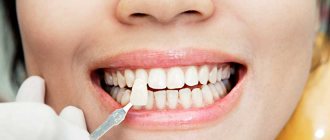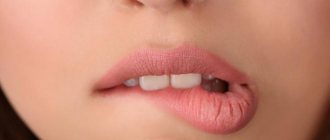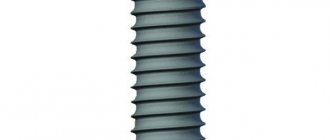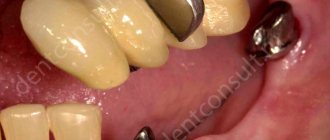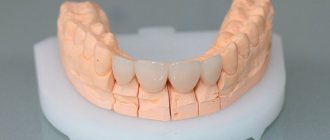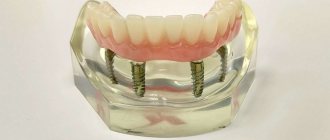The dream of a Hollywood smile will soon cease to be a dream. Unfortunately, we most often see straight, snow-white teeth only on the TV screen in advertising or with famous actors. In real life, every second person has dental problems. Currently, the problem of uneven teeth can be solved by modern braces systems that cope with any irregularities. The dreaded gray braces are a thing of the past. They were replaced by white braces, about which an abundance of information of a very different nature has recently appeared. What is fact in it and what is fiction? It is difficult for an ignorant person to navigate abstruse terms. Let's take a closer look at what this design is, how it differs from other orthodontic systems, and what the cost of such braces is.
White braces
What are the benefits of white braces?
It is unlikely that anyone will dispute that white bracket arches will have a much nicer appearance than a metal structure. Light-colored clasps are invisible: you can safely smile and not be ashamed of temporary inconvenience, as when wearing metal braces.
White braces have a more attractive appearance
This system comes in ceramic, sapphire and plastic. Its task is to make it easier for the patient to wear braces, making it less noticeable to others. However, this fact causes an ambivalent attitude towards him. Doctors and patients themselves were very wary of this new product on the dental services market. Their opinions were divided. In any case, the choice of a brace system is purely individual. Everyone chooses for themselves what they like best.
What do sapphire braces look like?
The sapphire bracket system, like most classic vestibular analogues, consists of the actual braces and arch. Some devices have a ligature - a fastening system for fixing the arc in the grooves.
Braces are small locks that have wings and a hole /groove/ for the arch. The arch passes through the slots of all braces and creates forces for the movement of teeth. For a sapphire system, the arc will be quite noticeable, since it is usually made of metal. However, the patient has a choice - at his request, but for an additional fee, a matte arch lined with a light composite material can be installed.
Truths and myths about braces with white wires
Those who believe that if the color of the arc is snow-white, then it is necessarily cast from a material of a similar color are mistaken. This is wrong. Teflon gives a light shade. Tetrafluoroethylene polymer is the most biocompatible with the human body. The color of this substance is white, and the staples themselves are made of metal. Different types are used: steel, titanium alloy, nickel and others.
Which metal braces are better?
Note! Teflon itself is very strong and does not respond to external irritants. However, there were times when he, despite his strength, began to “fly around”.
Peeling archwires do not threaten everyone - only lazy patients who do not want to come to replace them on time. It is recommended to do this once every month and a half, but many hope that the situation with “striped” braces will not affect them, delaying a trip to the dentist. As a result, the Teflon on the arch begins to fall off from continuous wear. Not a trace remains of its former beauty.
White braces are made from various materials
When installing braces, it is important to choose a trusted manufacturer who uses high-quality materials in the manufacture of structures. There is no need to chase the cheapest, trying to save money. Reliable manufacturers have excellent quality Teflon. With proper care, it never flies around or crumbles.
The appearance of such braces is more attractive, in contrast to their metal counterpart. However, among patients there are those who prefer a metallic shine on their teeth. They find it stylish and fashionable.
Some people prefer metal braces
There is still a drawback to braces with snow-white arches - increased treatment time. The culprit for this is arc coverage. It creates additional resistance at the moment when the teeth move. A solution to the problem was found by modern manufacturers - they managed to invent braces with a metal groove. They have much less frictional force, and by appearance they are indistinguishable from the classic version. The most famous companies are ZM and Ormso, which produce similar systems.
Choice of material and cost
It is difficult to answer the question of how much sapphire braces cost: the cost starts from 95,000 rubles. The price depends on the material from which they will be made. There are two types of products:
- Polycrystalline elements have a white matte surface. Such devices are not suitable for people who do not have a snow-white smile, as they will stand out very much against the background of their teeth.
- Monocrystalline designs are more expensive than the previous version, but their external characteristics are much better.
It is also worth deciding in advance on the corrective arches, since they can also vary. The design can be simple or sprayed. The latter option makes braces invisible.
System with ligatures
In addition, each model has its own fixation system. You can choose the ligature type, when the links are attached to a special elastic band. But it stains over time, which is why the device does not look very attractive, so it will have to be changed periodically.
Non-ligature products are secured using special locks with built-in grooves. These models are quite expensive, but more convenient and reliable. Many patients prefer this option when installing sapphire braces.
Unligated
Types of white braces
There are no metal white braces. It is a myth. Don't believe anyone who says otherwise. An attempt to connect white metal clasps with an arc is unsuccessful - it will still be noticeable. Such a design will clearly catch your eye, and there is no point in wearing it.
There are different designs of braces
Note! White arches come in combination with ligature or self-ligating structures. They are less noticeable due to the clasps attached to the arch with wire or rubber band.
The difference between white arcs and metal analogues
When choosing a bracket system, you should pay attention to the installed arch. It is she who plays a decisive role in the formation of the bite, creating the necessary degree of pressure. During the entire therapy process, the degree of pressure will change several times.
The characteristics of white and metal arc are similar. White wins due to the color that is created by processing the arc with special white enamel. The effectiveness of treatment does not suffer from this.
The effectiveness of treatment from wearing white braces will not decrease
The choice of orthodontic structures involved in correcting the bite is wide. You cannot do without prior consultation with a specialist. Only an orthodontist will ideally select the option that is right for you and indicate the treatment time frame.
To help those who can’t decide for themselves which braces system to choose, there are many videos on this topic on the Internet. A visual comparison of different designs will help you make the right choice.
Installation of sapphire braces
Before installation, preparatory measures are carried out - if necessary, fillings are placed and dental plaque is removed.
Important!
Any braces system is installed only on healthy teeth.
Then the patient takes a panoramic X-ray and a photograph of the skull, and is photographed in profile and frontal view. Based on the data obtained, a treatment plan is developed and the period of wearing the orthodontic device is determined.
Next, casts of the jaws are made to make a working model and accurately fit its parts. When the model is ready, installation is carried out. Braces are glued to the teeth, and an arch is inserted into their slots. It is she who will put pressure on each tooth, moving it in the right direction.
At the end of the procedure, which usually lasts at least two hours, the doctor removes excess glue from the enamel. This manipulation is mandatory, since the glue can stain and spoil the appearance of the teeth.
On a note!
Sapphire braces do not have to be placed on the entire row of teeth. They can only be used in the smile area, and conventional metal systems can be installed on the lateral teeth. This will reduce the final cost of the structure and save money.
Plastic braces with white arch
Metal braces are not always a pleasant sight. Now we can say that they are a thing of the past. They were replaced by a plastic system, which is a white arch on braces. She managed to gain popularity among patients in a short time. However, plastic structures had their drawbacks - the appearance of cracks and chips. Plastic braces were replaced by braces with a white ceramic arch, quickly displacing their predecessors.
Plastic structures are inferior in quality to metal and ceramic ones
White braces: how to straighten teeth without others noticing?
Many people still associate braces with unsightly metal structures that can turn any beautiful girl into ugly Betty. But orthodontics can be called one of the most developing areas of dentistry. Today, metal braces are far from the only way to correct a bite and straighten teeth. For a patient for whom aesthetics is important, the orthodontist may offer white braces. With them, the treatment process will take place unnoticed by others and comfortable for their owner. Let's figure out what kind of braces systems these are and find out how much white braces cost.
2 style=”text-align: center;”>What are white braces?
“White” braces are systems made of ceramics. The material used is their main difference from classic metal devices. The design of white and metal braces is identical:
- Small plates called braces are attached to the teeth, and an individual bracket is selected for each tooth;
- To fix the bracket, special cement containing fluoride is used, which provides the tooth with protection from caries during orthodontic treatment;
- Each bracket has a groove in which the arc “walks”;
- the arch is the most active part of the apparatus, it is given the correct shape, and in the process of wearing the structure, it moves the teeth in the desired direction;
- each plate has wings, ligatures are attached to them, holding the orthodontic arch in the grooves;
- some wings may have small hooks; the doctor will hook elastic cords onto them;
- pulls are elastic rings, the purpose of wearing which is to make the upper and lower dentition symmetrical and correct the bite;
- The design of braces includes locks and rings that are fixed on the distant teeth and serve as support for the arch.
White braces are no different in design from their metal counterparts.
Ceramic braces, like metal ones, belong to the vestibular apparatus, that is, they are installed on the outside of the teeth. There are also lingual systems that are fixed inside the dentition, on the side of the tongue, but these structures are not made of ceramics.
3 style=”text-align: center;”>What are white braces?
Aluminum oxide is used in the manufacture of the structure. Depending on the structure of the aluminum oxide crystal lattice, white braces are of 2 types:
- polycrystalline - they are called “ceramics”, the material is white, has low transparency and practically does not glare in the sun, recommended for installation in patients with a yellowish tint to the enamel;
- monocrystalline - they are often called “sapphire”, the material has a high degree of transparency, transmits light, sparkles in the sun, and is perfect for people with naturally white teeth.
3 style=”text-align: center;”>Advantages of white braces
High aesthetics is the main advantage of white braces.
White braces, as their photos eloquently demonstrate, outwardly outperform metal systems. They are almost invisible on the teeth, especially if they are braces with a white arch. If desired, of course, for an additional fee, the doctor will install for you not a metal arch, but an arch coated with a white composite. Your interlocutor, who is at arm's length, may not even notice that you are being treated by an orthodontist. It is precisely because of their high aesthetics that ceramic structures are very popular among adult patients and public people. And the sapphire braces with a white arch actually look like decoration - when the sun’s rays hit the structure, they sparkle.
Among the advantages of white braces, in addition to their attractiveness from an aesthetic point of view, it is worth highlighting:
- ceramics do not stain or change color when exposed to dyes in food and drinks;
- no additional discomfort occurs while wearing the device;
- the wearing period of the system, that is, the speed and effectiveness of treatment, is almost the same as when installing metal staples;
- The fastening of the plates to the tooth surface is reliable.
3 style=»text-align: center;»>Disadvantages of white braces
On white teeth, white braces look attractive, but on grayish and yellowish enamel they can be more noticeable.
Unfortunately, the system is not without its shortcomings. The disadvantages of white braces include their size, due to which the process of getting used to the system takes longer than in the case of metal devices. Elements of the system may more strongly rub the inner surface of the cheeks and lips with which they come into contact. Adaptation is especially difficult for young patients.
In some systems, the slots and latches of the brackets may be made of metal, while the plate itself is made of ceramic. This increases the reliability and strength of the bracket system, but does not have the best effect on aesthetics. If the patient chooses all-ceramic braces, made entirely of ceramics, the risk of device failure will be higher.
Caring for ceramic braces requires no less intensive and thorough care than any other orthodontic system. But you need to be more careful with ceramics, since these structures are more fragile compared to metal.
Another disadvantage of white braces is that in complex cases the system may be ineffective. If serious treatment is required, the doctor will recommend the patient classic metal braces.
The main argument against white braces for many is their cost. It cannot be called exorbitant, as is the case with lingual systems, but it is significantly higher than the price of metal braces.
Find out what a distal bite is and what methods can help you cope with it.
What kind of bite is called an open bite and what signs can be used to recognize it, you can read here.
2 style=”text-align: center;”>Which white braces should I choose?
There are many models of white braces from different manufacturers on the orthodontic market. We list the most popular systems and note their features:
- Mystique GAC - the system is manufactured in the USA, these are all-ceramic braces without metal inserts;
- Damon clear – non-ligature ceramic braces with a Spin Tek fastening system, thanks to which the size of the plates is significantly reduced;
- In Ovation – non-ligature all-ceramic systems with a rough base surface, making the fixation of braces more reliable;
- Clarity – white matte braces, with a metal groove in the base, which increases the strength and efficiency of the device;
- QuicKlear – reliability of fixation of the bracket system is increased due to the presence of hook-shaped protrusions on the base of the plates;
- Reflections - a ceramic system produced by Ortho Technology, its design provides for fixation of the arc in the grooves using ligatures;
- LUXI II Keramik - the system is produced by RMO, its feature is gold plating of the grooves.
Ligature, non-ligature, with a white or metal arc, with metal grooves or all-ceramic - the choice is huge.
3 style=»text-align: center;»>Cost of installing white braces
The cost of installing white braces depends on the model of the device that the patient chooses. Non-ligature systems are an order of magnitude more expensive than ligature systems, however, when they are installed, the patient less often has to pay for appointments with an orthodontist - whereas with ligature systems you need to go to the doctor every month, non-ligature systems require a visit every 3 months.
In each specific case, the cost of the entire orthodontic treatment can vary greatly. It depends on the complexity of the case, the period of treatment, and the patient’s oral health. Before installing the system, the patient will have to treat all teeth affected by caries, remove dental deposits, and eliminate inflammatory gum diseases, if any. If a patient's wisdom teeth are not growing properly, they will most likely have to be removed before orthodontic appliances can be placed. In some cases, it is necessary to remove healthy teeth in a row, especially with a narrow jaw and severe crowding of teeth. In addition, during the treatment process, the systems may break down, in which case you will have to replace the damaged elements with new ones, and this is an additional expense.
Prices may vary in different cities of the country. An important factor in pricing is the level of dentistry and the orthodontist, so the cost of installing braces can vary even in clinics of the same city.
Find out what can happen if you stop brushing your teeth.
What are trainers and when are they installed? Read here.
You can read how the bite is corrected in childhood here: //stopparodontoz.ru/u-rebenka-nepravilnyiy-prikus-zubov-chto-delat/.
Let's try to calculate the average cost of installing white braces:
- initial consultation with a doctor (often free) – up to 1000 rubles;
- diagnostics before treatment: taking impressions, orthopantomogram, drawing up a treatment plan - about 1,500 rubles;
- installation of white braces – about 150 thousand rubles (price for 2 jaws);
- correction of the system by an orthodontist - about 1000 rubles per visit;
- Removing the system, cleaning teeth, manufacturing and installing a retainer - about 5 thousand rubles.
When choosing between white vestibular systems and lingual devices, the patient should know that adaptation to the ceramic system is faster, the speed of treatment will be higher, and the cost will be lower. Comparing white bracket systems with metal brackets, one cannot help but note the high aesthetics of the former, which, of course, is reflected in the cost. The effectiveness of treatment and its duration are almost the same for metal and ceramic systems.
Ceramic braces with white arch
Important! The difference between the types of braces is in appearance, ease of wearing, and cost. Their effectiveness is almost the same.
Ceramic braces are divided into two types: ligature and non-ligature.
| View | Description |
| Ligature | Ligature braces are a lifesaver in the most severe cases of bite. Classic option. This brace system is attached to the arch using elastic rings or orthodontic wire. This design is reliable, inexpensive, and quite effective in combating malocclusion. This system serves as educational material for medical students. Thanks to this, many specialists know perfectly well how to work with it. |
| Unligated | Non-ligating or self-ligating braces come from the USA. The popularity of this system has declined significantly over the past decade. Among the advantages of wearing non-ligature braces are infrequent visits to the doctor and ease of care for oral hygiene. The downside is their large size. They replace the arch much faster than with ligature braces. Not everyone can work with this system. Additional training required. Treatment with self-regulating systems will be more expensive. |
There are ligature and non-ligature braces
White arc over water
We see a foggy arc - reflection of sunlight by droplets of water.
It looks like a rainbow, but does not have different colors. The fog itself does not form an arc - the fog is mostly transparent and relatively uniform.
The shape of the fog arc is created by droplets that refract sunlight at a certain angle in the direction of the observer. The lack of color in the fog arc is explained by the relatively small size of the water droplets. The light-refracting droplets are so small that their dimensions are comparable to the wavelength of light, scattering obeys the laws of quantum mechanics, and all colors mix.
If the droplets are larger, they act like small prisms that refract sunlight, creating a colored rainbow. This wonderful photo of a fog arc was taken last week with the Sun behind the photographer.
In the foreground are the rocks of Ocean Beach in San Diego, California, USA.
0
We also recommend:
● Mango
Mango belongs to a genus of plants in the Sumacaceae family, which grow in the tropics. “Mango” is also the name given to the fruits of these plants, which have a very sweet taste. The fruits of the tree are usually eaten...
● Purple raspberry (Japanese raspberry, Wine raspberry)
Purple raspberry, Japanese raspberry, Wine raspberry (lat. Rubus phoenicolasius) is a perennial climbing vine from the genus Raspberry, belonging to the Rosaceae family. Origin and distribution of purple raspberries The plant’s homeland is Japan, China ...
● Handsome Baikal: 10 facts
The deepest lake on the planet is located in Russia, on the territory of the Republic of Buryatia and the Irkutsk region. Beautiful Baikal with clean water, endemic flora and fauna is one of the main natural ...
● Barbados cherry (Acerola, Malpighia glabra, Acerola cherry)
Barbados cherry (Acerola, Malpighia glabra, Acerola cherry) (lat. Malpighia glabra) is a woody evergreen plant up to 6 meters high (in cultivation usually 1.5 meters) from the genus Malpighia and ...
● Heteromeles arborescens (Toyon)
Heteromeles arbutifolia (lat. Heteromeles arbutifolia) is a perennial evergreen shrub belonging to the Rosaceae family. Natural habitat: Southwestern California and Northwestern Mexico. In the entire genus of Heteromeles there is one species - ...
● Pepino (Melon Pear, Sweet Cucumber)
Pepino, Melon pear, Sweet cucumber (lat. Solanum muricatum) is a low evergreen shrub belonging to the Solanaceae family. Distribution of pepino The plant's habitat is South America, in which the plant is grown to produce ...
● Cherry plum
Cherry plum (lat. Prunus cerasifera) is a variety of plum, family Rosaceae. It has several other names: Plum splayed, S. cherry, etc. Until now, no one can say for sure whether it is ...
● Columnea consanguinea has bright red “hearts” on its leaves.
Columnea consanguinea blooms very inconspicuously. However, the cunning plant realized in time that pollinators could not be attracted by its frail flowers, and acquired bright red heart-shaped marks on its leaves. The main pollinator...
● Interesting things about forests
The forest is called the lungs of planet Earth and they say that without it life will disappear. But what really? About the occupied area Forests occupy about 38 million square meters. - approximately …
● Mother of pearl clouds
Over Murmansk one could observe a rare natural phenomenon - pearlescent multi-colored clouds. This is the first time such a unique event has been celebrated here. Murmansk residents witnessed a unique natural phenomenon. The sky over Murmansk shimmered...
● Circles in the sky
Peering into the sky on a sunny May day, photographer Jean-Marc Leclerc captured this beautiful view of halos forming complete circles in the sky. The photo was taken using a fisheye lens pointed straight...
● Why do hurricanes have human names?
Surely you have noticed that such formidable and dangerous natural phenomena are sometimes given gentle and subtle names. Who came up with this idea and, most importantly, why? The very first in this...
● Antarctic subglacial Lake Vostok
Lake Vostok in Antarctica is undoubtedly one of the most famous natural phenomena. There are no people like him in the world and this is perhaps the only thing that is known for certain about him, everything...
● Pecan
Appearance and description Pecans grow on deciduous trees with a thick, dark brown trunk that can be up to three hundred years old. The leaves on this tree resemble willow - medium-sized and...
● Guarana
Guarana (lat. Paullinia cupana) is a climbing vine from the genus Paullinia, belonging to the Sapindaceae family. Distribution of guarana Guarana is native to Brazil and Paraguay (Amazon basin), but individual specimens of trees are found ...
Pros of ceramic braces
The effectiveness of “ceramics” is high and is in no way inferior to metal braces. Ceramic ones are more comfortable to wear and look much better. Fine ceramics are used in the production of this system. This reduces the size of the braces, making them less bulky. The cost of this system is high, but you will have to pay extra for beauty and comfort.
Ceramic braces are more comfortable to wear
It is important to remember that if the bracket comes off, you cannot re-glue it - you will have to get a new one. Modern adhesive systems will help avoid accidental peeling. In addition, they serve as excellent protection for enamel from the effects of bacterial acid.
Important! The bracket system must be selected carefully. A lot also depends on the attending physician: his experience and knowledge in this area will help you not make mistakes and make the right choice, and the result will not be long in coming.
It is important to remember that if the bracket comes off, it will have to be replaced with a new one.
Features of the sapphire system
The distinctive features of its design are aesthetics and the absence of any discomfort during operation. The device itself is made of stone, which is grown under artificial conditions. This material is absolutely safe and does not cause allergic reactions.
The crystal lattice that is part of the stone gives it strength, so it is not inferior in hardness even to diamond, and its beautiful shine makes your smile dazzling. The device works by applying pressure from the device to the crown, causing the teeth to move and align.
Unlike their ceramic counterparts, sapphire staples neutralize plaque and are not stained. As for strength, it is not inferior to metal structures, but the product looks more aesthetically pleasing.
The arcs that connect the elements are made of transparent material, so they are also difficult to see, and even more so in bright sunlight, when the stone begins to shine. Due to these qualities, the design is recognized as the most highly aesthetic bracket system.
Sapphire braces with white arch
This braces system has the most aesthetic appearance. For their production, transparent, strong artificial crystals are used, which become invisible upon contact with saliva. When light hits their surface directly, the crystals sparkle beautifully. Before they become braces, the crystals undergo careful processing. And the locks, treated with a special solution, sit firmly and do not fall off.
Sapphire braces have the most attractive appearance, but they are much more expensive
Anyone who has a bite problem can afford sapphire braces. Their wide variety will help you choose the system that is needed in a particular case. Installing the system will not hit your pocket hard. In appearance, the sapphire design is slightly inferior to the “ceramics” and lingual system. But they will fully emphasize the individuality of their owner.
Note! The disadvantage of this system is that, despite the strength of sapphire braces, they can crumble slightly when removed. In this case, the remains from the tooth will have to be cut down.
Advantages and disadvantages
Considering the pros and cons of sapphire products, it is worth noting their main advantage is strength and reliability. They are based on a crystal lattice that can withstand various loads without collapsing. In addition, the crystals are pre-treated, so they adhere tightly to the tooth surface and do not chip or fall off. It is also worth highlighting several more advantages:
- securely fastened;
- do not injure soft tissues and do not damage tooth enamel;
- look aesthetically pleasing;
- do not stain;
- capable of transmitting neon light.
The main disadvantage of sapphire braces is the cost. Not everyone can afford such devices. But the cost can be significantly reduced by installing a combined system.
Sapphire (metal teeth are used on chewing teeth to reduce the cost of the system)
Who should wear white braces, and who should do without them?
Reducing the friction force between the arch and the groove, as planned by the manufacturers of white braces, was supposed to speed up the treatment process, but this did not happen. Such a system both slowed down the correction process and continues to do so. Experts advise using this system during treatment in the final phase. Usually by this time the teeth have already aligned. The only thing left to do is to create the right contact between them.
Wearing braces is recommended only for people who are willing to carefully care for such a structure.
Installation of white braces is suitable only for clean people who take care of oral hygiene and do not miss visits for correction. Those who are negligent in these procedures risk an unpleasant yellow color to the prosthesis. It can break, crumble, and the arcs will resemble worn out, rusty wire.
White braces are placed on one row of teeth, usually the ones that are most visible when smiling.
Care requirements
During the treatment period, you must follow some rules and carefully care for your braces. In addition, it is necessary to carry out special measures and use auxiliary products that are designed to cleanse the oral cavity. Basic recommendations:
- carry out daily oral hygiene procedures;
- Teeth cleaning is carried out with special brushes that have tick-shaped bristles;
- it is necessary to use dental floss, rinses and brushes that are intended for braces;
- After eating, be sure to remove all food debris;
- give up sweet and hard foods;
- use an irrigator (a special electrical device that releases liquid), the water pressure allows you to clean even the most inaccessible places;
- Regularly visit the clinic for arch replacement, design correction and professional hygiene.
Reviews from owners of a sapphire braces system indicate that it does not cause discomfort, pain and does not impair diction. The adaptation process takes place in a matter of days. Patients do not hesitate to smile, because they know that the design is almost invisible. In addition, in a short time it copes with its main task, namely correcting malocclusion and straightening teeth. So the high cost of staples is completely justified.
Procedure for installing braces
The patient does not feel any pain when installing the braces system. It won’t take much time either: a few trips to the doctor will be enough.
The first step is an inspection. The doctor will consult the patient and determine the further course of treatment.
Before installing braces, a person will have to visit the doctor several times.
In some cases, certain preparation of the oral cavity for installation is required.
The system will not be installed until the person has treated his bad teeth. If there is inflammation or caries, then they must be eliminated. It is advisable to have it professionally cleaned.
Important! If everything is fine with the teeth, then no additional treatment will be prescribed. The doctor will draw up a treatment plan and estimate how much it will cost to install braces.
The second visit will take a little longer than the first. As if at a photo shoot, the doctor will photograph a person’s jaw from different angles, either in profile or in front. A panoramic photograph of the jaw and an x-ray of the skull will be taken. Next, the doctor, looking at the results of the tests obtained, will select a treatment regimen. By the third visit she is usually ready.
The specialist will take several photographs to make arches
Coming to the orthodontist for the third time, the patient gets acquainted with the further treatment regimen selected specifically for him. The person receives a contract to sign, where the amount of treatment is clearly stated, and gives his consent if he is satisfied with everything.
The fourth trip to the doctor is the final one. Braces are being installed. Each tooth is treated with a special glue, and a bracket is attached to it separately. Immediately after this, they are all connected using arcs. The work is labor-intensive and painstaking, requiring close attention and concentration. Installation typically takes two hours.
After this, the patient should not forget to visit the clinic for correction once a month. The doctor will adjust the archwire or replace it. If improper care or irregularities during installation occur, the braces may come off. Such cases are rare, but occur in medical practice. Here you will need to replace the entire bracket system.
After installing braces, you must regularly visit your doctor to correct them.
At first, patients feel discomfort. Speech becomes unclear, and the lining of the cheeks and tongue may be slightly scratched by braces. Swelling may appear. This occurs when such systems are installed on the inside of the teeth. It will take some time to get used to wearing braces. As a rule, this takes from several days to a couple of weeks. No outside intervention is required - everything will go away on its own. You just need to be patient.
Important! The timing of bite correction is influenced by the complexity of the pathology in each case specifically, and not by the braces installation system, as most believe.
The complexity of the pathology influences how quickly the bite is corrected.
Video - A girl about her experience in installing white braces
WHY THESE BRACES?
Advantages
- The treatment is invisible to people, which means you do not experience embarrassment or emotional discomfort when communicating
- Favorable price: less than for a braces system installed on the inside of the teeth
- Guaranteed results if you follow the orthodontist’s recommendations
Flaws
- Slightly longer treatment period. This is due to the characteristics of Teflon, which inhibits the “sliding” effect due to its properties
- The white arc may lose its hue because the Teflon wears off due to the mechanical impact of rough food. In this case, you need to replace the arc with a new one.
- The design is slightly more expensive than the vestibular one, made of metal
The final choice is yours, but only an experienced orthodontist can help you finally decide on the choice of braces.
4 advantages of orthodontic treatment in the World of Dentistry network
- Our doctors treat orthodontic problems taking into account the entire range of problems in your oral cavity. The treatment plan is drawn up taking into account the wishes and individual characteristics of each patient.
- We guarantee that the first positive results will be noticeable within 1 month.
- Consultation with an orthodontist, if you say that you learned about this offer on the website: mirstomatology.rf, is FREE!
- Before treatment begins, we will tell you about the proper care of braces and the desired diet during the treatment period.
How to care for braces?
Don't forget that when wearing braces, your teeth still need care as much as before. Failure to comply with oral hygiene rules can lead to the development of caries, which is extremely undesirable. The doctor, seeing caries, may stop treatment and force the braces to be removed without waiting for a complete cure.
In order not to damage the braces, it is better to eat non-solid food. Gnawing on nuts, bagels, and sweets is strictly prohibited. It is also better to avoid chewing gum. You should not take risks and experiment with the strength of your braces system.
Avoid chewing gum while wearing braces
Hot or very cold food can also damage your braces. They may begin to peel off from the teeth.
It should be remembered that ceramics and sapphire in braces react very sensitively to coffee drinks and tobacco. From their excessive use, the surface of the braces can change its snow-white color to yellow. The same applies to strong tea. Red wine lovers will have to switch to white, although this does not affect the effectiveness of treatment.
Well-known manufacturers, in order not to lose face in front of the consumer, carefully test their product for resistance to color changes. Only cheap and low-quality braces change color.
Important! It should be taken into account that caring for teeth with ceramic braces is much more difficult and the process of cleaning “ceramics” takes much longer.
Teeth with ceramics must be brushed every time after eating.
Teeth with ceramic braces will have to be brushed after meals every time instead of the usual “morning and evening”. You will have to purchase a special orthodontic toothbrush at the store. It perfectly cleans the space between the tooth surface and arches. At the final stage of brushing your teeth, you need to use special dental floss.
Kinds
White braces are divided into several main types, each of which has its own distinctive features.
Ceramic
The most effective and popular orthodontic system today is made of ceramics.
Ceramic systems, in turn, are divided into two more subtypes:
- monocrystalline: matte white model;
- polycrystalline: the system has a low transparency coefficient, the color of the arc is selected as close as possible to the color of the patient’s tooth enamel, so they are practically invisible on the teeth.
Ceramic structures have the following advantages:
- aesthetic appearance;
- comfort when wearing the system;
- are firmly fixed to the enamel and remain in place until completely removed.
Sapphire
Sapphire braces are by far the most aesthetic system for correcting malocclusion.
If a white arch is used for fixation, then from a distance it is very difficult to see them on the surface of the teeth.
To manufacture such a system, artificially grown crystals are used.
This correction system looks more like a decoration than an orthodontic mechanism.
The duration of wearing such structures depends on the situation, its average duration is from 12 to 24 months. This system is much more expensive than ceramic braces.
Plastic
Plastic braces are the first aesthetic system for correcting malocclusion, which replaced standard metal ones. The orthodontist selects the color of the plastic and the color of the arch so that it matches the color of the patient’s tooth enamel as closely as possible.
Therefore, in its appearance, such a system can be compared with ceramic or sapphire braces. The main advantage is the reasonable cost: in some clinics the difference between plastic and ceramic systems can differ by 2-3 times.
However, despite significant advantages, such a system also has its disadvantages:
- plastic, unlike ceramics and sapphires, is a fragile material, so mechanical impact from the outside can cause breakage;
- plastic structures require frequent visits to the dentist:
- the correction period is significantly increased due to the fact that the teeth move into the correct position much more slowly than in the case of ceramic or sapphire braces;
- Plastic is a material that is susceptible to coloring, so this system introduces a number of restrictions on the use of coloring products. Frequent consumption of even tea or coffee will turn the braces brown after a certain time, and they will lose their aesthetic appearance. You will also have to exclude all coloring berries, fruits, wine, juices and sparkling water from your diet. To avoid darkening of the plates, people who smoke will have to give up their addiction while wearing braces.
Frequent correction of plastic systems significantly increases their total cost, and in some situations the total costs may even exceed the price of ceramic or sapphire braces.
Duration of therapy and effectiveness
The duration of wearing braces may vary depending on the severity of the crooked teeth. On average, treatment takes 18 months, but for some, a year is enough. The metal from which the braces are made does not matter, and this does not affect the wearing period.
Treatment usually lasts from one to one and a half years
You can enjoy the first results in three months. Despite the improvement, no one will allow you to remove your braces. Early withdrawal is fraught with bad consequences. The position of the teeth may return to their previous state, and you will have to start all over again.
Rules for caring for teeth with braces
Comparison of ceramic braces with other types of braces
If we compare ligature ceramic braces, reviews from orthodontists and patients agree that these braces are as strong and reliable as metal ones, but at the same time they are much more invisible on the teeth.
Table 1
| Ceramic/sapphire braces | Metal braces | Lingual braces | |
| Aesthetics | high | low | perfect |
| Reliability | high | very high | low |
| Treatment speed | high | high | low |
| Frequency of orthodontic visits | 1 time every 2 months | 1 time every 2 months | as needed |
| Convenience for patients | quick adaptation | quick adaptation | difficult adaptation |
| Treatment price | high | moderate to high | transcendental |
In addition to the fact that you need to somehow make a choice between ceramic, metal and lingual braces, you also need to make the right choice between braces models from different manufacturers. To find out whether there are important differences between braces from different companies and which ones are better to choose, read the articles:
How to remove braces?
You won’t be able to remove braces yourself: this requires special tools. Preparation for the procedure should begin in advance. It needs to be professionally cleaned within a few days. When removing, the doctor uses a polishing bur, carefully removing any remaining adhesive from the surface of the teeth. However, after being freed from braces, it is not always the same color: sometimes you can find light spots on it. Their appearance is the result of the activity of bacteria that cause caries. This happens due to poor teeth cleaning, since it is not always possible to remove plaque under and around the braces. This leads to demineralization of tooth enamel.
You cannot remove braces yourself - this should only be done by a doctor.
Thanks to modern technologies, this problem can be solved. Some companies have learned to preserve the color of teeth after removing braces using a special transparent glue. At the moment of attachment, it serves as an excellent sealant, spreading evenly and adhering tightly to the surface of the tooth. Thus, it protects the enamel not only under the bracket, but also in the space around it.
After removing braces, another step follows. Retainers are replacing the bracket system.
Retainers are completely invisible to others. They come in two types: removable and non-removable.
The removable retainer is a plastic structure. This cap is completely transparent. You need to wear it for a year, almost without taking it off, and every day, giving your teeth a break from it for only four hours a day. In the second year, there is no need to wear a mouthguard for days. You only need to insert it at night, but do not forget to do it daily.
After braces are removed, the person will need to wear a retainer for a period of time.
A permanent retainer has a metal base that looks like an arch. It is attached to the inside of the teeth.
It is necessary to wear retainers, because if you neglect treatment and refuse them, then everything will go down the drain. The teeth will quickly return to their original state, and the treatment process will have to be repeated from the very beginning.
Popular manufacturers
There are several companies specializing in the manufacture of ceramic braces systems. The main components of the designs are the same, but they also have their differences.
Clarity
The company produces aesthetic non-ligation braces systems; they are transparent, so they are practically invisible on the teeth . The design’s clasps are anatomical, which allows them to fit as closely as possible to the surface of the tooth.
They have a microcrystalline surface at the base and an anatomical contour of the base. Each brace is individually packaged and marked.
Damon
These designs differ in the structure of the braces. The company produces non-ligature systems; wire or rubber ligatures are not needed for their fastening.
photo: Damon Clear combined braces
The arc is attached to the locks themselves, this allows you to keep its mobility under control. The metal arch in braces is closed with the help of special caps that hold it. This design allows the use of softer arcs.
Reflections
Systems from this company are predominantly ligature. Reflections ceramic systems are composed of polycrystalline aluminum oxide. This material is durable and almost transparent. This allows us to characterize the systems from this company as aesthetic.
Usually ligatures stain over time, but Reflections braces do not. Ceramics are resistant to food dyes, as well as chemical and temperature influences. Such systems do not cause allergic reactions.
In-ovation
The newest non-ligature systems are lingual (which are installed on the back of the teeth) and vestibular. These are aesthetic systems; they do not injure the mucous membrane.
In such designs, rubber bands and wires are not used; there is a special mechanism for controlling the arc. Systems from this company allow you to track and control the movement of each tooth.
Cost of white braces
Prices for white braces in the capital are not that high. Braces for both jaws will cost about forty thousand rubles - this is the price for a plastic structure. True, their popularity has fallen sharply: they are no longer in such demand as before, since in most cases the quality of such structures leaves much to be desired. It is better to overpay and purchase a ceramic bracket system. The pleasure is expensive, but it's worth it. Installing braces on one jaw will cost approximately 45 thousand rubles. However, ceramics look better and are more durable than plastic. The main thing is to treat it with care.
The cost of ceramic braces is much higher than plastic ones
Sapphire designs with a white arc will cost the most: about 60 thousand rubles for one jaw.
One way or another, when choosing a material for braces, you need to consult a doctor: he definitely won’t give bad advice. Looking at the condition of the teeth, he will determine which braces system is most suitable for a particular patient.
Flaws
Ceramic braces systems have their advantages and disadvantages. Their main disadvantages include:
- High cost - not every person can afford to install such systems. They are made of high-strength quality material, which increases their cost. Also, the price depends on the type of structure.
- The treatment period is slightly longer compared to metal braces. This occurs due to the fact that ceramics puts less pressure on the teeth, which slightly prolongs the period of their alignment.
- If ceramic braces fit too tightly to the enamel, this can lead to changes in its color, composition and destruction. The doctor regulates the tightness of such systems.


